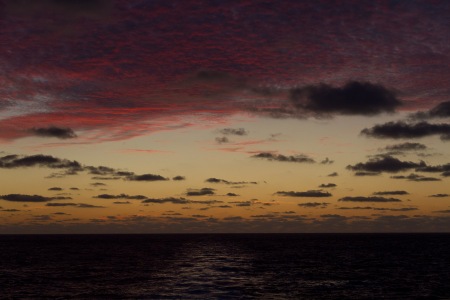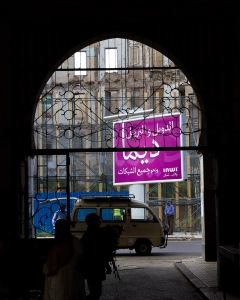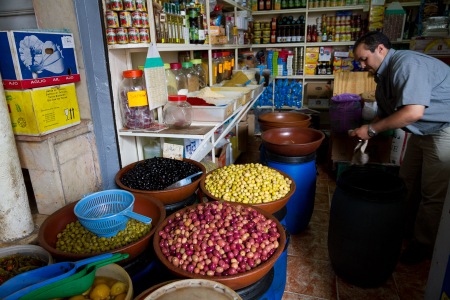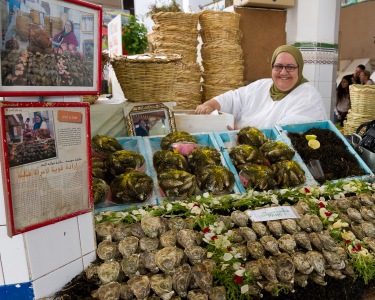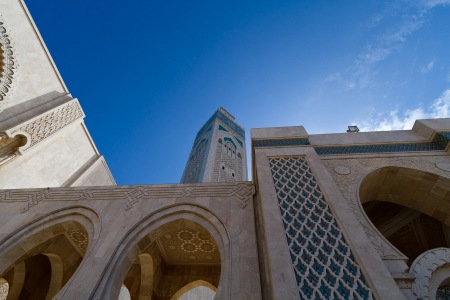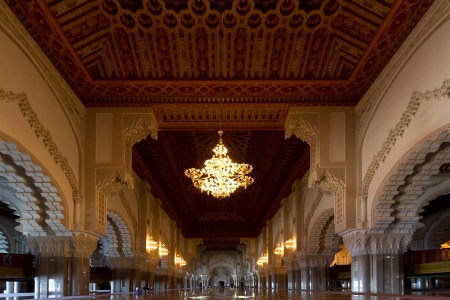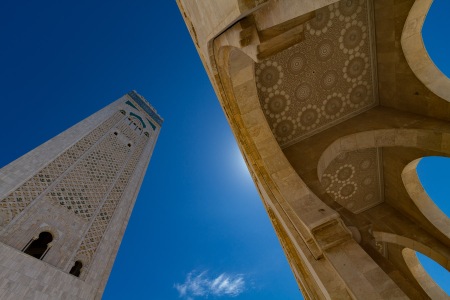September 2, 2011: “This is where our first exposure to Moroccan culture really begins, and it was much like diving head first into something you can’t quite see, or, perhaps more accurately, don’t really understand. The medina is a maze of interconnected streets, paths and narrow walkways (souks), all along which are set up little storefronts, perhaps six to ten feet wide, usually about twenty feet deep. The paths are only occasionally big enough that you might consider them one-way streets , but you still find many motor scooters, bicycles, and yes, the occasional car. The souks are more or less covered using everything and anything; tarps, fabric, sticks, wood, vinyl banners, metal… detritus of any and all sorts. Others are open and narrow, perhaps two stories on either side. Not unlike markets in Mexico (or, I’m sure, many other places), you can find all kinds of stuff, from leather goods, shoes, knockoff purses, jeans, various textiles and pottery, to spices, fish, pig, local crafts, as well as trinkets and geehaws of all sorts… [continued below gallery]
…I have read and we have heard much about the bargaining customs of Morocco, but nothing can truly prepare you for it. Especially if you don’t have any small bills or coins to cut your teeth. Walking around with nothing but 100 dirham bills (about $12.50 USD) is like an automatic invitation to pay 100 dirhams for something, anything, regardless of how much it’s actually worth. It’s not like we walked around triumphantly waving our bills in the air once we finally negotiated the local ATM, but it seemed a bit hard to try and pay 20 MDH for something if you don’t actually have 20 MDH ready, in hand. Lesson #1 learned: Small currency=good. Next, we were (as predicted in many blogs) ‘adopted’ by a little old Moroccan guy (yes, named Mohamed), who wanted to show us all around the market, only subtly offering what I first considered to be ‘help’. As he continued to try and talk to us in very broken English (mostly Arabic, as far as I could tell), Heidi’s recently-acquired ‘cabbie radar’ started to take over, and she kept trying to abort the mission to find Tate an inexpensive Moroccan soccer jersey. Reade and I were kind of enjoying the randomness of it all and Tate just wanted the shirt, so Heidi was soundly outvoted by us men on our quest. We finally got to ‘his’ place with the cheap soccer jerseys, and ended up negotiating down to 150 MDH from the initial offer of 250. Paid about $20 for the $20 soccer shirt, after which our self-pronounced ‘guide’ wanted 40 MDH for his services. This mightily perturbed the lovely and usually laid back Heidi, and she furiously tried to walk away in disgust, while I felt a bit sorry for our guide and suggested we should give him at least something (I can’t believe I didn’t get a picture). After going back and forth and Heidi objecting to my offering him 20 MDH (she offered him one), I asked her if she’d pay $3 to make him go away. Without missing a beat, Heidi looked at him and said: “Will you go away if I give you this???” He emphatically said “Yes, yes, yes” and Mohamed took the twenty-spot and he was gone. It was well worth the 20 dirhams, and after paying about 20 bucks for a 20 dollar Casio watch for Reade, we were ready to be done with our shopping day, especially the boys, who were overstimulated in a whole new way. Lesson Learned #2: It’s probably best to generally avoid anyone who seems to want to help you, especially if they approach you (I’d say your odds are better avoiding a scammer if you pick the odd person on the street and ask for help) .
We continued walking Casablanca’s medina with the goal being to get to the outside of the wall, all-too-slowly learning that showing interest in something is bad, making eye contact with anyone selling anything is an invite to a ‘friendly arm over the shoulder’ (urging-nudging-pulling you into his shop), and completely ignoring any and all comers after your first “No thank you” is the order of the day. Don’t touch the item, don’t ooh and aah over it, and never, ever hold it with your own two hands, as they’ll never accept it back (which, to a Moroccan vendor, appears to mean you already bought it). Kapiche?”
Morocco in the rear view:
9/7/11: “Only one day out from departing Morocco, I find myself wanting more time in the medinas, wishing that we could have seen the town of Fes, a place where time has stood nearly still, things still being done in the same ways they were centuries ago. The haunting call to prayer over loudspeakers both near and far, the extraordinary sights and sounds of Djemaa el-Fna in Marrakesh, hustle and bustle in the dark corridors of the souks; all provided an experience that will stick with me, despite the fact that we still have 12 more countries to visit. Being that Morocco was our first international experience as a family, I think it will serve a lasting impression on the boys, as well.
Some things that never quite fit in with previous blog posts while in Morocco follow. Mostly observations, some factoids learned along the way, etc.
Morocco’s government is still a monarchy, but a democratic one with a parliament (women hold 30 seats), etc. King Mohammed VI seems to be well liked, probably one of the more progressive kings for an Islamic country. The ‘Arab Spring’ that is currently taking hold in other Islamic countries appears to be less prolific here, at least we saw few overt signs (no political rallies, etc.).
Fashion is alive and well in Morocco, and despite what is described as a traditional Islamic culture, many locals could be seen baring skin that a decade or two ago would have been unthinkable. Apparently people can freely dress however they wish (especially in big cities like Casablanca), but assumptions will be made as to one’s character, based upon one’s choices in clothing. Morocco is 98% Islamic (mostly Sunni), with a smattering of catholics and fewer of the jewish faith.
30% of the population is less than 15 years old (55% <25 years old) and unemployment remains high (13%), as evidenced by the plethora of people wandering the medinas, looking for various creative ways of parting tourists with their money. Average annual income is less than $2000 USD per year, with more rural populations making only $1 to $2 a day. Birth rates are coming down (currently <3), as are mortality rates.
Phosphates are the primary export while tourism is growing rapidly, with services topping 50% of the country’s GDP. Almost every light fixture I saw in Morocco was fluorescent; funny to think that they are ahead of the U.S. in implementing this energy-saving technology. As described previously, satellite dishes could be seen on even the most modest shack, and internet cafes abound. Cell phones are very common, with people able to use them even deep in the cavernous souks, physical locations where AT&T couldn’t provide a signal in the States if they tried.
Lastly, a story told by one of the Lifelong Learners during the Post-Port reflection meeting tonight:
After she had watched Moroccan women using rocks to bang open the nuts of an argan tree, she stood in line to buy some argan oil (rich in Vitamin E), a specialty of Morocco. She got to the cashier, who asked: “Is that a 3 or a 4?” She was puzzled, and had to ask her what she was enquiring about. It was the iPhone in her hand.
Such a fascinating intersection of ancient tradition and modern culture.”
If you’d like to visit my original Blogspot post for this country, please start here: 9/3/11: Casablanca, Morocco

